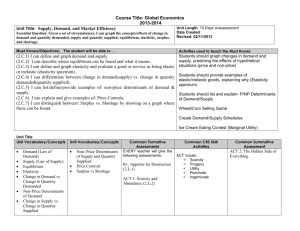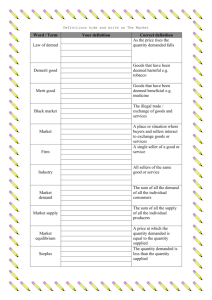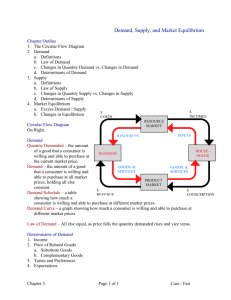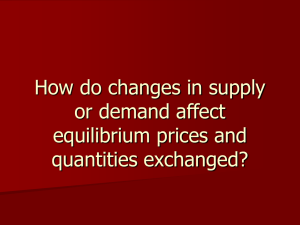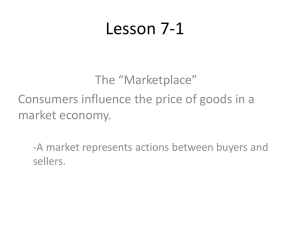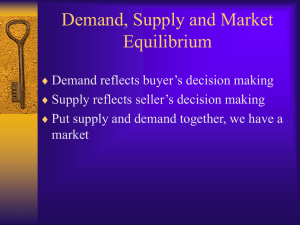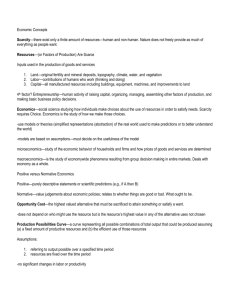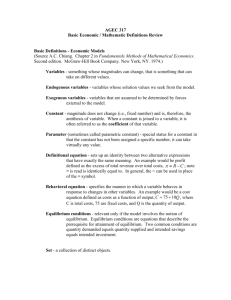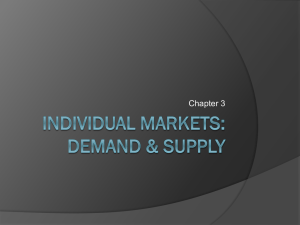Supply and Demand - Federal Reserve Bank of Dallas
advertisement
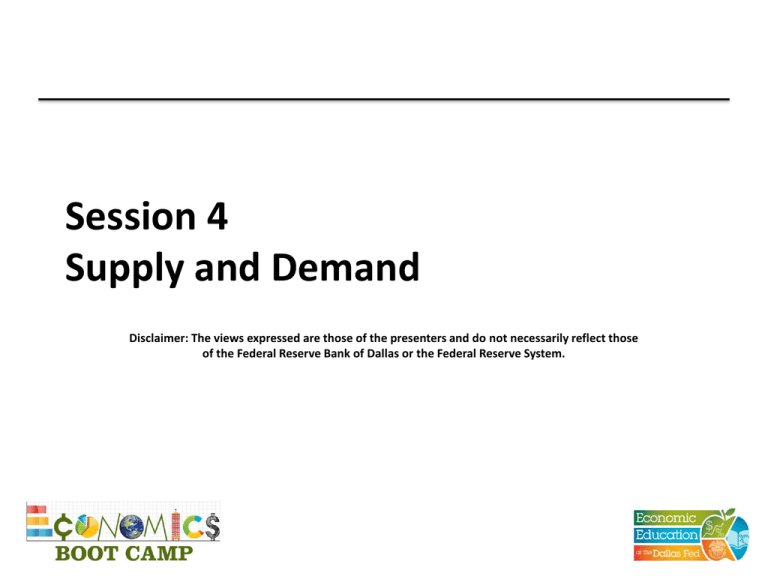
Session 4 Supply and Demand Disclaimer: The views expressed are those of the presenters and do not necessarily reflect those of the Federal Reserve Bank of Dallas or the Federal Reserve System. TEKS (2) Economics. The student understands the interaction of supply, demand, and price. The student is expected to: (A) understand the effect of changes in price on the quantity demanded and quantity supplied; (B) identify the non-price determinants that create changes in supply and demand, which result in a new equilibrium price; and (C) interpret a supply-and-demand graph using supply-and-demand schedules. Teaching the Terms • • • • • • Market Demand Supply Determinants Surplus Shortage Markets • A market facilitates the interaction of a buyer and a seller as they complete a transaction • Buyers, as a group, determine the demand • Sellers, as a group, determine the supply Characteristics of Competitive Markets • Identical goods or services • Enough buyers and sellers so that no participant can influence the market price – everyone is a price taker Demand • • • • • Law of demand Quantity demanded Demand schedule Demand curve Determinants of demand The Law of Demand As the price rises, the quantity demand falls. Demand Quantity $5 $4 $3 $2 $1 10 20 30 40 50 Demand for ____ 6 5 4 Price Price 3 2 1 0 10 20 30 40 Quantity 50 Determinants of Demand • Income • Price of related goods – Complements – Substitutes • Tastes or preferences • Expectations • Number of buyers Shifting Demand 8 7 6 Price 5 4 3 2 1 0 10 20 30 Quantity 40 50 Supply • • • • • Law of supply Quantity supplied Supply schedule Supply curve Determinants of supply The Law of Supply As the price rises, the quantity supplied rises. Supply Quantity $5 $4 $3 $2 $1 50 40 30 20 10 Supply of ____ 6 5 4 Price Price 3 2 1 0 10 20 30 40 Quantity 50 Determinants of Supply • • • • Input prices Technology Expectations Number of sellers Shifting Supply 8 7 6 Price 5 4 3 2 1 0 10 20 30 Quantity 40 50 Market Equilibrium Price Quantity Demanded Quantity Supplied $5 $4 $3 $2 $1 10 20 30 40 50 50 40 30 20 10 Market Equilibrium 6 Supply 5 Price 4 3 2 1 Demand 0 10 20 30 Quantity 40 50 Market Equilibrium Surplus • Quantity demanded is less than quantity supplied Qd < Qs Equilibrium • Quantity demanded is equal to quantity supplied Qd = Qs Shortage • Quantity demanded is greater than quantity supplied Qd > Qs Practice • Draw the graph. • Which curve is shifting because of the changing market conditions? Supply? Demand? Both? • Which direction is the shift? • Draw the shift. • What is the impact on price and quantity? Price Controls • Price Ceiling – If price is fixed BELOW the market clearing price – Creates a shortage because Qd > Qs • Rent controls • Price Floor – If price is fixed ABOVE the market clearing price – Creates a surplus because Qd < Qs • Minimum wage Price Elasticity of Demand • Measures the responsiveness of quantity demanded to a change in price • Determinants – Availability of close substitutes – Necessities versus luxuries – Definition of the market (food vs. ice cream vs. chocolate ice cream) – Time horizon Price Elasticity and Total Revenue • If demand for a good is elastic, price increases lead to lower total revenue • If demand for a good is inelastic, price increases lead to higher total revenue Price Elasticity of Supply • Measures the responsiveness of quantity supplied to a change in price • Determinants – Availability of inputs – Time Questions?

